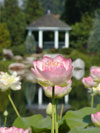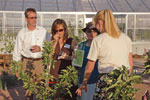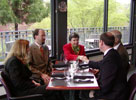As summer winds down and cooler temperatures tempt us out of air-conditioned comfort, what better place to consider for small functions than a garden? Groups can see the transformation of seasons in a setting as relaxed as it is beautiful. Many gardens around the country can be booked for events, and the following are especially keen to attract meetings.
Lewis Ginter Botanical Gardens
Richmond, Va.
Because it began life as a private estate, Lewis Ginter Botanical Gardens offers a feature rarely found in public gardens: a historic home that doubles as an event space. The 80-acre garden is off Interstate 95 north of downtown Richmond in a historic neighborhood.
 |
| Lotuses bloom at the Lewis Ginter Botanical Gardens in Richmond, Va.
Courtesy Lewis Ginter Botanical Gardens. |
Its Bloemendaal (Dutch for “Valley of the Flowers”) House is specifically marketed for meetings and events. The first floor, arranged as a living space with couches, chairs and a dining table, flows comfortably to verandas, patios and a tent set up from April to October. Between the house and the tent, there is 4,000 square feet of event space.
“I’ve often seen small groups out there under the tent with their whiteboards working, and they really seem to be enjoying the environment,” said Beth Monroe, public relations and marketing director. “Our facilities take people out of their day-to-day space and inspire creativity.”
The home and five other meeting venues make it easy to understand why the garden attracts clients such as Virginia Commonwealth University, Anthem Blue Cross and Blue Shield, and Tredegar Corp.
The most business-oriented meeting space is a 2,448-square-foot auditorium. With all the trappings for business, it still maintains its connection to the garden with a glassed-in prefunction space and terrace.
Popular for small social functions is a 1,500-square-foot teahouse with wraparound decks and three walls of glass. Guests traverse a small bridge in the Asian garden to reach it.
Groups can add private garden tours to the meeting package or take advantage of regular summer programs by scheduling events on the same nights.
(804) 262-9887
www.lewisginter.org
Botanica
Wichita, Kan.
Botanica is a welcome change of scenery in downtown Wichita, Kan., and a hot spot for groups in search of a creative, natural meeting place. In 2007, 583 events, from annual meetings to church picnics, were held at the urban garden.
The Terrace Room, with seating for up to 400, is the largest of three indoor meeting spaces.
“Last year, a company set up a product showcase in the Terrace Room so customers could come in and preview their new products for the year,” said Mia Jenkins, director of marketing. “We have also had groups rent the Terrace Room just so they could use the sunken terrace outside. The terrace has wrought-iron tables and chairs, is surrounded by plants and has a water feature. Sometimes, they never even go inside.”
It’s easy to understand why. Botanica’s nine and a half acres of gardens showcase native Midwest plants and many others you wouldn’t expect to find there.
In a relatively small space, gardeners have designed 25 theme areas, some devoted to birds, others to butterflies and another to Shakespeare. A new children’s garden will soon be in the works.
A covered pavilion with wrought-iron tables and chairs for 60 is open to the garden but feels secluded enough for private events: a bank client-appreciation dinner, a women’s re
 |
| Because it was once a private estate, Lewis Ginter Botanical Gardens in Richmond, Va., has some unusual venues including a historic home.
Courtesy Lewis Ginter Botanical Gardens |
ligious retreat and a hospital recruitment event, for example.
Its downtown location makes the garden a good stopping point for receptions and dinners, too. Many groups offer afternoon garden tours for spouses and then bring the whole group together for a dinner in the garden.
“We have a golf course across the street, and some groups have held golf tournaments in the afternoon and then come over here afterward for dinner,” said Jenkins.
(316) 264-0448
www.botanica.org
Winterthur
Wilmington, Del.
Henry Francis du Pont would be happy to know that the standards he set as host for events at Winterthur are still being followed.
“Mr. du Pont was world-renowned for his hospitality, and we try to maintain that standard,” said Nicole Bailey, catering director for the estate’s in-house caterer, Restaurant Associates.
The 1,000-acre country estate near Wilmington, Del., is as famous for its 60 acres of gardens as it is for its house museum, stuffed with Early American art and antiques.
Du Pont wanted his gardens to blend into the natural landscape, and they do, from the spring bulbs planted en masse in the March Bank to the tall hardwoods and blooming dogwoods layered over eight acres of azaleas and rhododendrons in the Azalea Woods.
Pondering by a reflecting pool
On a pretty day, a small group might gather near a reflecting pool or in the conservatory. More traditional meeting spaces in the visitors center can accommodate 300 and more when adjacent areas are tented.
Law firms, banks and corporations looking to spend time out of the boardroom are typical clients.
“A lot of them will meet for a while and then come out and do team-building events like scavenger hunts,” said Bailey. “Or they’ll take time out to take a behind-the-scenes tour in the museum, listen to a lecture by our historian or horticulturist, or take a shuttle ride around the property for a quick tour. Some groups just offer free time in the schedule to walk around the gardens.”
The lush surroundings and richness of the estate and museum holdings set an air of expectation for food at a Winterthur event, and Restaurant Associates strives to offer original and sophisticated options.
“In the early 1900s, everything was sustainable and locally produced, and we present foods that are in season, light and elegant,” said Bailey.
And just like the artwork, museum displays and garden landscape, the Winterthur staff keep the food as historically accurate as possible, often using du Pont’s own dessert recipes, making the food fit the atmosphere.
(800) 448-3883
www.winterthur.org
Powell Gardens
Kingsville, Mo.
The harvest is especially important in the Midwest, producer of
 |
| Powell Gardens, 30 miles from Kansas City, in Kingsville, Mo., provides a productive landscape for brainstorming sessions and retreats. During breaks, meeting attendees can design a scarecrow, plant trees, carve pumpkins or take tours.
Courtesy Powell Gardens |
much of the nation’s food. A new 12-acre Heartland Harvest garden at Powell Gardens, 30 miles east of Kansas City, Mo., shows visitors not only where much of their food comes from but also how to incorporate food plants into the landscape.
“It all started with a temporary international vegetable garden that we planted when the garden opened 20 years ago,” said Callen Zind, director of marketing. “A few years later, we took it out to build our visitors center, and people were upset and wanted their vegetable garden back.”
The rebirth of the vegetable patch has spurred other developments. Greenhouses have become classrooms, a modern-style barn and silo has become a place to gather and dine,and graceful allees formed by fruit trees have become places to get acquainted.
Retreat in a productive landscape
Amid this productive landscape, groups can brainstorm, retreat and strategize. The visitors center has space for up to 175 during the day and even more after hours when its Grand Hall becomes available. The new barn has barely lost its new-paint smell, and groups are already scheduled to meet in the open-air facility that overlooks the new gardens.
 |
| Courtesy Powell Gardens |
Volunteerism is a big part of Powell Gardens’ success, and groups that meet there often get into that community spirit. Sandra Haught, tour and rental manager, said groups use a variety of activities to break up their meetings.
“We have done classes on making botanical bookmarks and picture frames, butterfly gardening, bird watching, forcing bulbs, making herbal vinegars and wreaths, and even making concrete stepping stones,” said Haught. “Another group made a scarecrow for the garden. Some have helped us carve pumpkins in the fall, and others have just scheduled time to help plant trees and work in the garden.
“They might only spend an hour working in the garden, but it really helps the groups feel like they’re giving back to the community,” said Haught.
(816) 697-2600
www.powellgardens.org
Coastal Maine Botanical Gardens
Boothbay, Maine
The windswept coast of Maine might be the last place you’d expect to find a botanical garden, but the 3-year-old Coastal Maine Botanical Gardens in Boothbay, Maine, proves that rugged terrain can be fruitful.
The garden salutes its setting with trails along the tidal waters and a visitors center of heavy stone and cedar shakes, evocative of local architectural style.
Garden cafe billed best place for lunch
Based on recent recognitions, a meal at the garden should be in the plans. The visitors center cafe has been named the best place for lunch in the area by Yankee Magazine. Much of its acclaim is owed to the locally sourced foods — some even grown on site — that the cafe serves.
“I think we’re one of the first gardens to be serving foods that are grown in their own garden,” said Barbara Freeman, director of communications. “We are also composting much of the waste from the café, including the plastic silverware and plates, which are made from cornstarch and will break down naturally.”
Meetings and events are primarily held after hours to take full advantage of the 9,350-square-foot visitors center, where several rooms accommodate groups of up to 150. Garden tours and horticultural activities can be added to the itinerary.
Smaller groups often get out into the gardens to reflect. For example, the Maine Haiku Club brought a picnic lunch and met in a shoreline pavilion to read and discuss poetry.
“The group took a break and let everyone walk out in the garden alone to work and think,” said Valerie Tu’ineau, events coordinator. “The garden has a lot of water features and all kinds of spaces you can tuck yourself into. Afterward, they came back and read more of their poetry.”
(207) 633-4333
www.mainegardens.org
Cape Fear Botanical Garden
Fayetteville, N.C.
For now, dinners and parties at the Cape Fear Botanical Garden must be held beneath a tent, but that will all change in early 2011, when a new 34,000-square-foot visitors pavilion becomes the 79-acre garden’s grand entrance and a new off-site meeting space.
 |
| The teahouse at Lewis Ginter Botanical Gardens is an option for small meetings.
Courtesy Lewis Ginter Botanical Gardens |
The pavilion’s highlight will be the Orangery, an octagonal event space, with a domed 50-foot ceiling and skylight, filled with plants and palms. It will give the garden space for dinners of up to 400 and receptions of up to 1,000.
A grand hall that leads to the Orangery from an entry pavilion will be used for prefunction or meeting space.Surrounding the pavilion will be two walled gardens and a plaza.
Location makes garden natural choice
The garden’s location will aid in making it a natural choice for meeting planners. Just off Interstate 95, it is two miles from downtown Fayetteville, but its location, at the confluence of the Cape Fear River and Cross Creek, makes it feel much farther away.
Fifty acres along the water remain in a natural state; the rest of the developed garden is known for its daylily, camellia and hosta gardens.
(910) 486-0221
www.capefearbg.org











